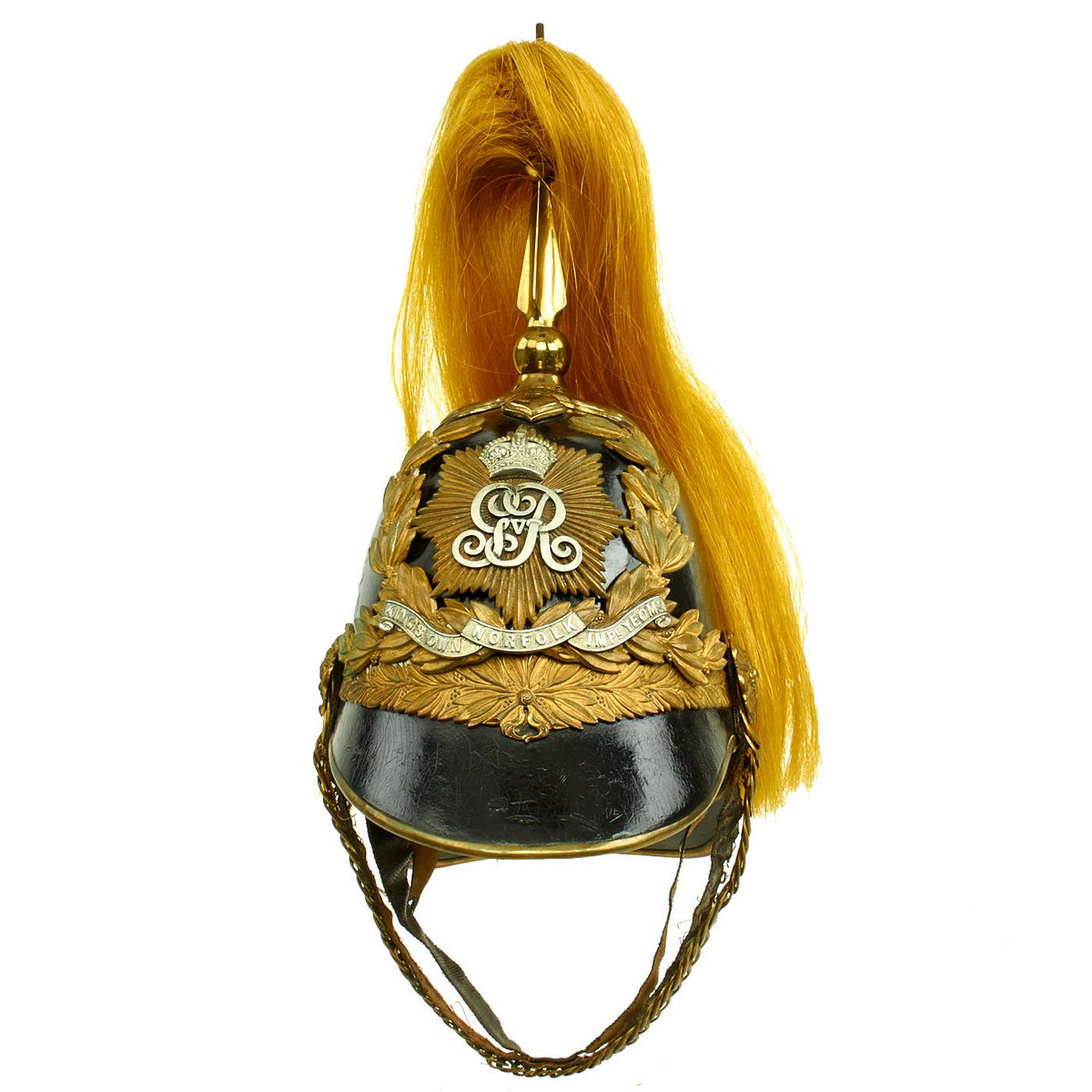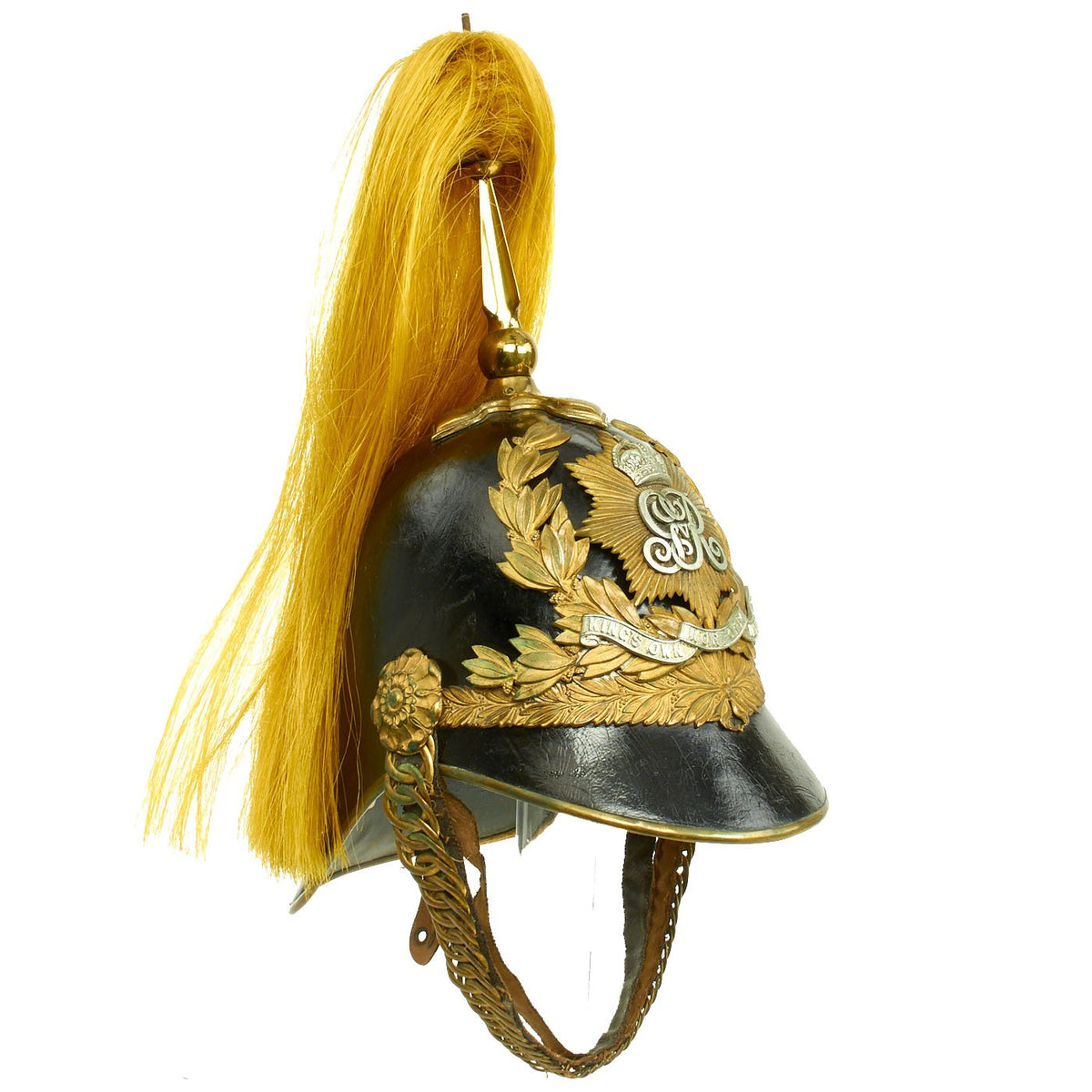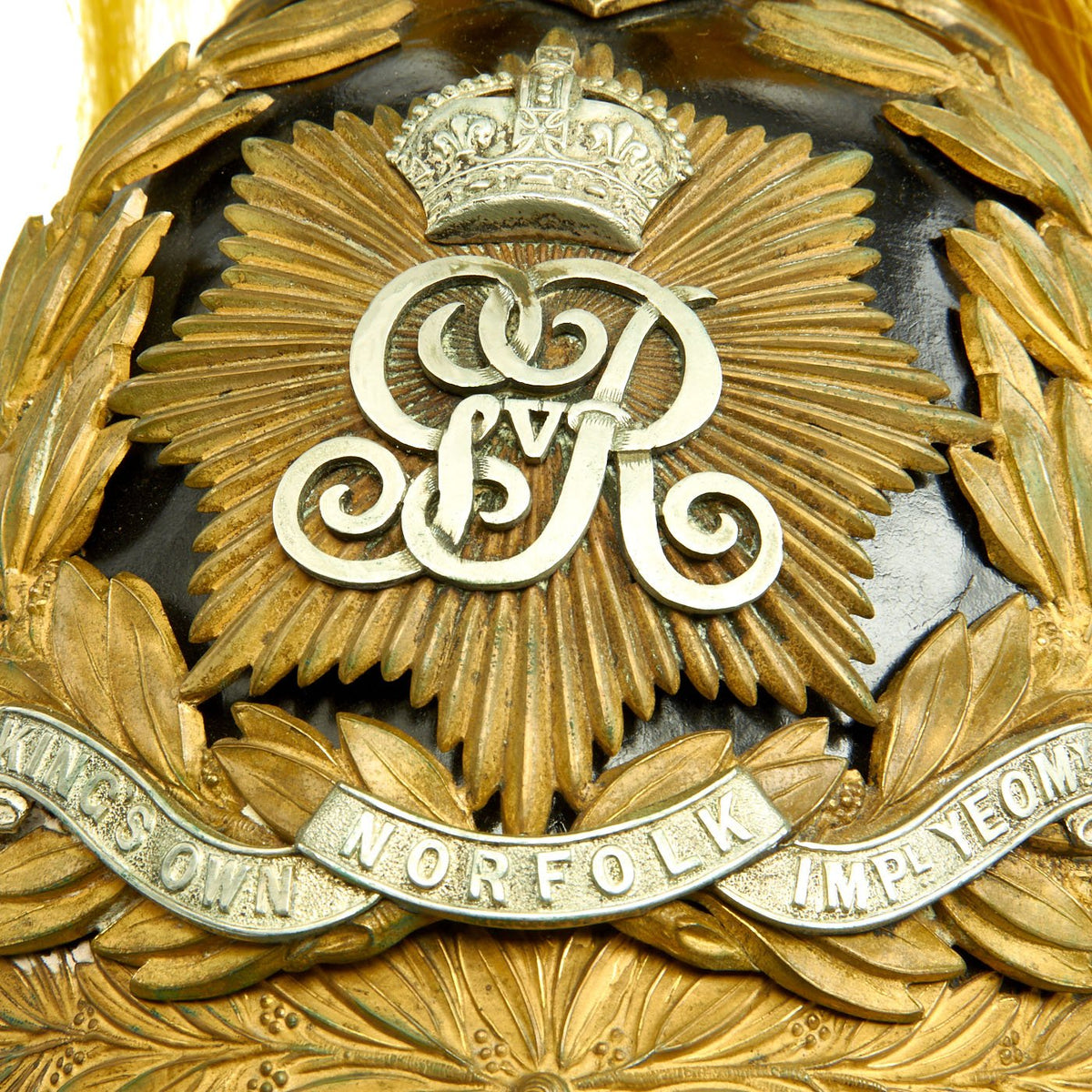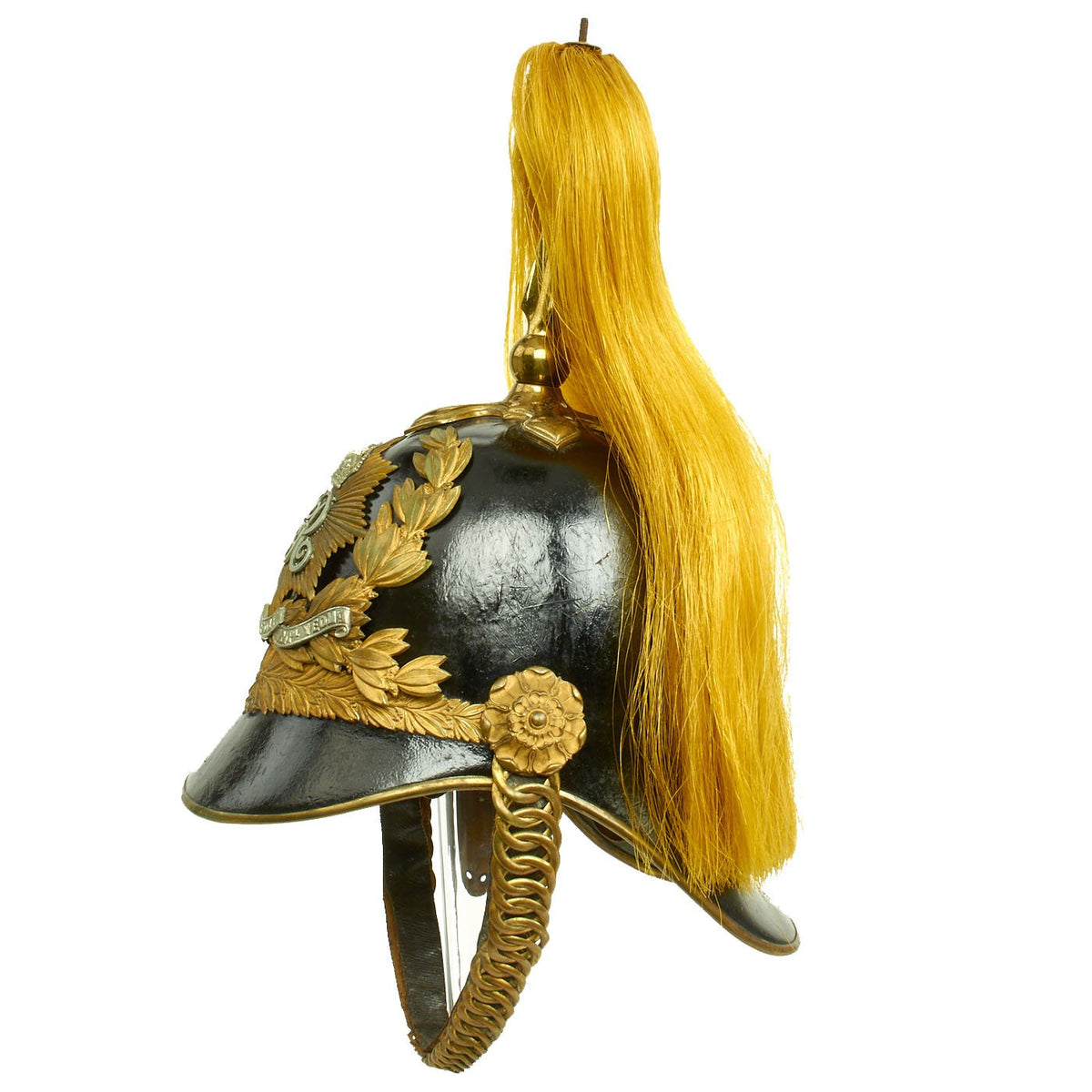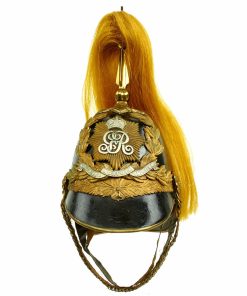Original British George V King’s Own Norfolk Imperial Yeomanry Officer Parade Helmet Original Items
$ 1.095,00 $ 273,75
Original Item: Only One Available. Dating from the reign of King George V 1910-1936 this is a fantastic Norfolk Yeomanry The King’s Own Royal Regiment Officer’s parade helmet. Features a black leather patent skull mounted with gilt metal laurel leaf band and rosettes, the regimental helmet plate with GRV cypher over starburst star plate (officer) and tri-part title scroll (King’s Own Norfolk Imperial Yeomanry), the helmet surmounted by spike with saffron yellow horse hair plume (top rosette missing), and original leather liner. Interior is nicely maker marked HAWKES & CO a well known hat and uniform marker in London. Size is approximately US 7 (56cm) offered in very good condition.
The Norfolk Yeomanry was a volunteer cavalry (Yeomanry) regiment of Britain’s Territorial Army accepted onto the establishment of the British Army in 1794. After seeing action in the Second Boer War, it served dismounted at Gallipoli, in Palestine and on the Western Front during the First World War. Between the wars it converted to the Royal Artillery (TA), and served as an anti-tank regiment in France, the Western Desert, Italy and North West Europe during the Second World War. After the war it served as a TA air defence unit and then as an Army Air Corps unit.
First World War
Mobilization
In accordance with the Territorial and Reserve Forces Act 1907 (7 Edw. 7, c.9) which brought the Territorial Force into being, the TF was intended to be a home defense force for service during wartime and members could not be compelled to serve outside the country. However, on the outbreak of war on 4 August 1914, many members volunteered for Imperial Service. Therefore, TF units were split in August and September 1914 into 1st Line (liable for overseas service) and 2nd Line (home service for those unable or unwilling to serve overseas) units. Later, a 3rd Line was formed to act as a reserve, providing trained replacements for the 1st and 2nd Line regiments.
1/1st Norfolk Yeomanry
On the outbreak of war in August 1914 the Eastern Mounted Brigade became part of the 1st Mounted Division and served with it in coastal defence at Woodbridge, Suffolk, until September 1915, when it was sent to reinforce the Allied force at Gallipoli.
Gallipoli
The Eastern Mounted Brigade left 1st Mounted Division and embarked without their horses at Liverpool on the RMS Olympic, sailing on 25 September 1915 for Lemnos.The Norfolk Yeomanry, with 25 officers & 504 men, were under the command of Lt-Col A. F. Morse. Having arrived at Mudros harbour on 1 October, the brigade had to remain on board until 8 October, when the Norfolk and Suffolk Yeomanry transhipped to the Abassieh, but bad weather prevented them from landing at ANZAC Cove until 10 October.
On arrival the brigade was attached to the 54th (East Anglian) Division, with the Norfolk Yeomanry joining the 1/8th Hampshire Regiment and the 1/4th Essex Regiment on 14 October for instruction in trench warfare in the Hill 60 area. After a week they relieved the 1/6th Essex and took over the Norfolk Street sector until they were relieved in turn by the 1/4th Norfolk Regiment and returned to the New Bedford Road rest camp on 26 October. Throughout November the regiment took turns in the trenches to the right of Hill 60, suffering a trickle of casualties. By the end of the month casualties amounted to 200 out of 500 other ranks, mostly from sickness.
The decision having been made to abandon the campaign, the first party of the Norfolk Yeomanry was evacuated to Mudros on 14 December, the remainder following five days later, these detachments being among the last to be evacuated from the Suvla beachhead on 20 December.
Egypt and Palestine
The regiment landed in Egypt in February 1916, where the South-Eastern and Eastern Mounted Brigades were merged to form the 3rd Dismounted Brigade and were engaged on digging defences for the Suez Canal. In July they were moved to Sollum and Mersa Matruh on the Egyptian coast as part of the Western Frontier Force defending Egypt against the Senussi. In early 1917 the dismounted brigades were moved from Western Egypt and organised into 74th (Yeomanry) Division, with the Norfolk Yeomanry being redesigned from 7 February as the 12th (Norfolk Yeomanry) Battalion, Norfolk Regiment in 230th Infantry Brigade. The 12th Norfolks went into the trenches at Deir el Balah on 12 April in preparation for the advance into Palestine. The 74th Division remained in reserve during the Second Battle of Gaza (17–19 April), and afterwards 230th Bde held the line of Wadi Ghuzzee during May before moving into divisional reserve in June.
The 74th Division began a period of intense infantry training in August. The Third Battle of Gaza opened on the night of 30 October with the Yeomanry taking up positions on the far side of Wadi Ghuzzee. 230th Brigade supported the attack at 08.30, the Norfolks on the left. All the battalions came under shrapnel fire and progress through the gullies was slow. The brigade came within 1000 yards of the Turkish position by 10.40, by which time the men were crawling beneath machine-gun fire. But covered by their own artillery and machine-gun barrage, they cleared the opposing trenches soon after 12.15. The Yeomanry began consolidating the position, but were still under long-range fire from the next Turkish position, so 230th Bde was sent forward to take this position as well. By now the objective of Beersheba had fallen to the Australian Light Horse.
The next phase of the battle, as far as 74th Division was concerned, came on 6 November, when it attacked towards the railway line. The advance had to be made over open country to the enemy position which was at least 4000 yards away, but the attack was remarkable for the speed at which the battalions advanced, taking several enemy gun positions. After the victory, the division was left to clear the battlefield, and only caught up with the rest of the army on 23 November, when it began attacking into the hill country.
The division was relieved on 4/5 December and shifted round to attack towards Jerusalem from the west. The night approach for the attack on 8 December was difficult and the troops were late in jumping off (at 05.35). They then had to descend into a steep wadi and climb the other side. The Norfolks on the left took 35 minutes to climb the slope, where they found the Turks had abandoned their trenches but were holding walls and rocks just behind the crest. The Yeomanry worked their way forward over a mile and a half of difficult country and reached the village of Beit Iksa by 11.30. Here they were held up by flanking fire from Nebi Samwil, and established an outpost line. The following morning the enemy had disappeared, and the advance was made with hardly a shot fired, while Jerusalem fell into British hands.
The offensive was renewed between 28 and 31 December, with the brigades alternating in the lead. After the Capture of Jericho the British forces continued the advance north until 8 March 1918, when the division attacked the Tell Azur position. The 12th Norfolks were in reserve as the brigade crossed the Nablus Road and advanced over broken ground. They then took over the advance, but did not arrive until the afternoon because of the difficult approach. Their task was to scramble down a rough slope before crossing a bridge and then climbing a formidable terraced hill, beyond the crest of which lay the objective (Hill K12), and it was decided to wait until dusk. The battalion lost formation in the dark and the descent was swept with machine gun fire, but the Norfolks found a single practicable path down the slope. At midnight the climb began, with the Turks throwing grenades down on them until they reached the crest. The advance towards K12 was resumed at 06.00 on 9 March but was halted by machine gun fire and exhaustion. Supporting troops continued the advance, but it ended on 12 March and the line achieved was consolidated.
Colonel J.F. Barclay led a raid with two companies of his Norfolks on the night of 23/24 March, but the success of the German Spring Offensive on the Western Front meant that active operations in Palestine had to be shut down, and reinforcements sent to France.
France and Flanders
On arrival in France, the 74th Division conformed to the smaller establishment of divisions in the British Expeditionary Force, releasing three spare battalions, including the 12th Norfolks, which on 20 June were formed into 94th (Yeomanry) Brigade in the 31st Division.
The 12th Norfolks fought with 31st Division in the following actions of the Hundred Days Offensive:
La Becque (28 June)
Capture of Vieux Merquin (18 August)
Fifth Battle of Ypres (28 September–2 October) [little bit in Edmonds]
Tieghem (31 October).
2/1st Norfolk Yeomanry
The 2nd Line regiment was formed in 1914 and by January 1915 it was in the 2/1st Eastern Mounted Brigade in the Huntingdon area. On 31 March 1916, the remaining Mounted Brigades were ordered to be numbered in a single sequence;[29] the brigade was numbered as 13th Mounted Brigade and joined 4th Mounted Division in the Wivenhoe area.
In July 1916, the regiment was converted to a cyclist unit in 5th Cyclist Brigade, 2nd Cyclist Division, still in the Wivenhoe area. In November 1916, the division was broken up and regiment was merged with the 2/1st Suffolk Yeomanry to form 7th (Suffolk and Norfolk) Yeomanry Cyclist Regiment in 3rd Cyclist Brigade, in the Ipswich area. In March 1917 it resumed its identity as 2/1st Norfolk Yeomanry, still at Ipswich in 3rd Cyclist Brigade. By July 1917 the regiment had moved to Woodbridge. In May 1918 the regiment moved to Ireland and was stationed at Castlereagh and Gort, still in 3rd Cyclist Brigade, until the end of the war.
3/1st Norfolk Yeomanry
The 3rd Line regiment was formed in 1915 and in the summer it was affiliated to a Reserve Cavalry Regiment in Eastern Command. In the summer of 1916 it was attached to the 3rd Line Groups of the East Anglian Division. Early in 1917 the regiment was disbanded and its personnel were transferred to the 2nd Line regiment and the 4th (Reserve) Battalion of the Norfolk Regiment at Halton Park, Tring
Fast Shipping with Professional Packaging
Thanks to our longstanding association with UPS FedEx DHL, and other major international carriers, we are able to provide a range of shipping options. Our warehouse staff is expertly trained and will wrap your products according to our exact and precise specifications. Prior to shipping, your goods will be thoroughly examined and securely secured. We ship to thousands clients each day across multiple countries. This shows how we're dedicated to be the largest retailer on the internet. Warehouses and distribution centres can be located throughout Europe as well as the USA.
Note: Orders with more than one item will be assigned a processing date depending on the item.
Before shipping before shipping, we'll conduct a thorough inspection of the items you have ordered. Today, the majority of orders will be delivered within 48 hours. The delivery time will be between 3-7 days.
Returns
The stock is dynamic and we cannot completely manage it because multiple stakeholders are involved, including our factory and warehouse. So the actual stock may alter at any time. It's possible that you may not receive your order once the order has been made.
Our policy is valid for a period of 30 days. If you don't receive the product within 30 days, we are not able to issue a refund or an exchange.
You can only return an item if it is unused and in the same state as the day you received it. You must have the item in its original packaging.
Related products
Uncategorized
Uncategorized
Armoured Fighting Vehicles of the World: AFVs of World War One (Hardcover Book) New Made Items
Uncategorized
Armored Burgonet Helmet & Polearm from Scottish Castle Leith Hall Circa 1700 Original Items
Uncategorized
Uncategorized
Uncategorized
Uncategorized
Uncategorized
Uncategorized
Uncategorized
Uncategorized
Uncategorized
Uncategorized
Angolan Rebel 1970s era 60mm Inert Display Mortar from Angolan Civil War Original Items
Uncategorized
Uncategorized
Uncategorized
Uncategorized
Uncategorized
Band of Brothers ORIGINAL GERMAN WWII Le. F.H. 18 10.5cm ARTILLERY PIECE Original Items
Uncategorized
